The dispute over the Senkaku/ Diaoyu Islands comprising five uninhabited islands and three rocks totalling seven square kilometres in the East China Sea is often understated as a simple sovereignty dispute or a resource conflict. It may, in fact, be the defining element of East Asian maritime security and geopolitics. In addition to China and Japan (and Taiwan), the involvement of the United States in this dispute by virtue of its security treaty with Japan makes it potentially explosive.
Uotsuri Island, which is the largest island in this chain (4.32 sq km.), is strategically located close to Okinawa Island (Japan), Taiwan and the Chinese mainland. There are two lighthouses and a miniature Shinto shrine on the Uotsuri Island, but the rest of the islands are undeveloped1. Earlier this year in July, Chinese ships were spotted near the Japan-administered Senkaku Islands for a record hundred consecutive days since mid-April, the longest streak since Tokyo put them under state control in 2012. Chinese vessels also entered Japan’s territorial waters for a total of 11 days since April 14, triggering a string of stern diplomatic protests by Tokyo.
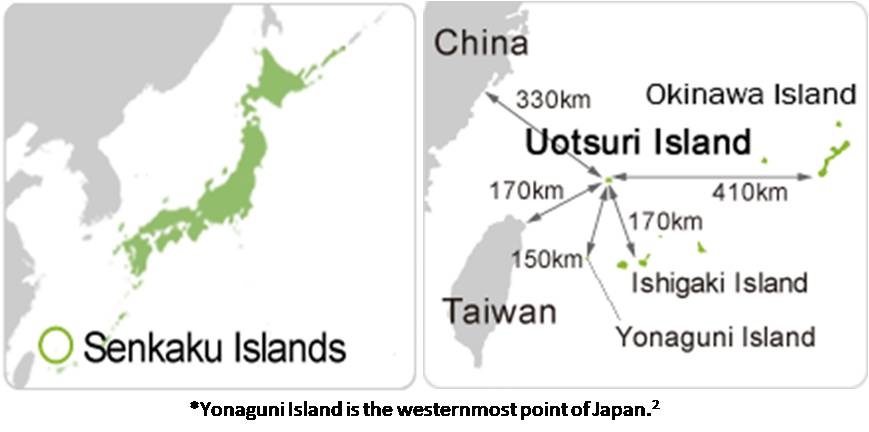
Background to the Dispute
While the conflict has been simmering under the radar for many decades now, it has come to the forefront in the last decade. In September 2010, the year China surpassed Japan to become the world’s second largest economy, the collision of a Chinese trawler with Japan’s Coast Guard vessels near the Senkaku Islands prompted a major diplomatic row. Thereafter, a drop in rare-earth shipments by China to Japan, which reportedly lasted until the end of November 2010 and then resumed at less than previous amounts, was keenly felt in Japan’s high-tech industry. The Japanese government would then pre-empt a controversial sale of the Minami-kojima, Kita-kojima, and Uotsuri islands by purchasing them from the Kurihara family for ¥2.05 billion in 2012. The Kuriharas had obtained the islands for an undisclosed amount in the 1970s from Zenji Koga whose family had brought them from the Japanese government in 1932 after running a fish processing plant on Uotsuri jima3.
On November 23, 2013, China unilaterally established an Air Defense Identification Zone over the East China Sea that included the airspace over the Senkakus. In 2017, the Japanese Defense Ministry announced that the Air Self-Defense Force fighters were scrambled 1,168 times, with 73% of them against Chinese aircraft, in fiscal 2016 — the largest number since 19584. From then on increased military incursions from China have seen a rapid year-on-year increase in the waters around the Senkaku Islands.
History of the Dispute
Following China’s defeat in the first Sino-Japanese war 1894-95, and consequent signing of Treaty of Shimonoseki in April 1895, Japan acquired vast territories from Qing China. However, stating the principle of terra nullius, the Japanese government argues that the Senkakus became Japanese territory under international law through their incorporation by a cabinet resolution adopted on January 14, 1895 (three months prior to the treaty)5. On the other hand, the Chinese and Taiwanese governments trace their ownership historically back to the 15th Century and dispute Japanese ownership. They maintain that the Senkaku Islands are covered under the phrasing in the treaty as "islands appertaining or belonging to said island of Formosa"6. After Japanese surrender during World War II, the island chain was controlled by the United States until 1971, when it was returned to Japan along with Okinawa and other surrounding islands. The dispute came into prominence following the 1969 United Nations Economic Commission for Asia and the Far East (UNECAFE, later renamed ESCAP) report that mentioned that the region between Taiwan and Japan “appears to have great promise as a future oil province of the world”.
A Resource Conflict?
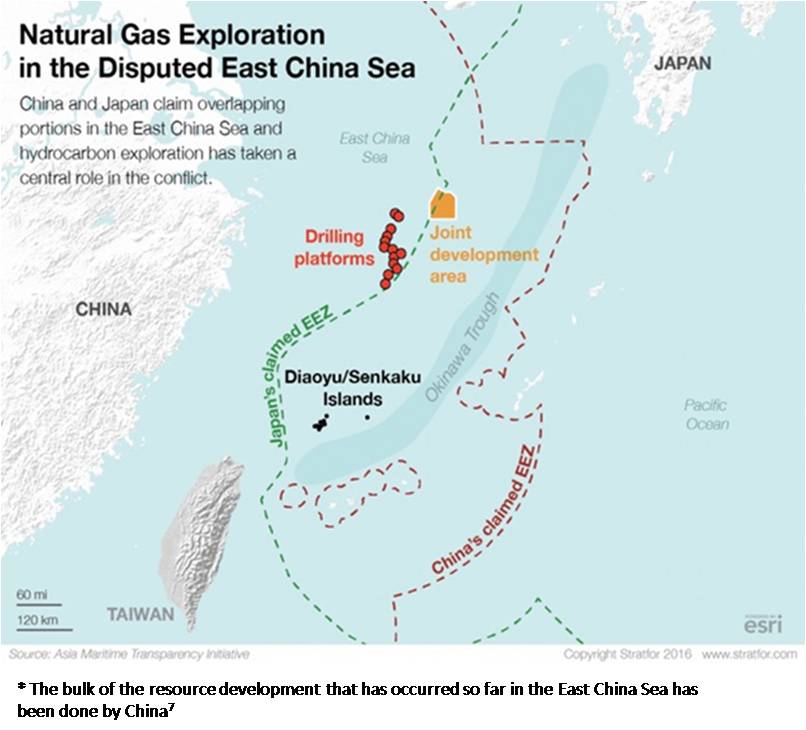
While Chinese sources predict as high as 160 billion barrels of oil and 250 trillion cubic feet of gas in East China Sea, the US Energy Information Administration (EIA) estimates between 60 and 100 million barrels of proven/probable oil reserves, and currently 1-2 trillion cubic feet of natural gas with some potential for further gas discoveries. Little evidence has been found of the Chinese-estimated 160 billion barrels of oil8. The Chunxiao/Shirakaba field (discovered in 2004) is the most promising field with gas reserves of 168 billion cubic feet. Studies have long shown that a pipeline from the East China Sea to the Japanese mainland would be expensive and technologically intimidating because of the distance and the two thousand meter plunge the ocean floor takes at the Okinawa Trough. Infact, in the 1980s after the discovery of the Pinghu oil and gas field, Japan co-financed two oil and gas pipelines running from the Pinghu field to Shanghai and the Ningbo onshore terminal on the Chinese mainland through the Asian Development Bank and Japanese Bank of International Cooperation9.
Thus, after a series of confidence building measures in the early 2000s, the 2008 agreement mooted the joint development of resources by China and Japan in East China Sea. The equation of fishing rights with the extension of a nation’s sea power is well established in East Asia. Also, a point to emphasise is that China is today both the world’s largest seafood market and the world’s largest seafood exporter. But the constant swarming of Chinese fishing vessels into East China Sea remains a massive challenge for Japan. Many a time, doubts are cast on the existence and activities of the People’s Armed Forces Maritime Militia. PAFMM plays an important role in establishing a de facto Chinese operating presence in disputed areas—in effect, changing the facts on the ground, or at sea, as it were—to challenge counter-claimants' ability to maintain control over disputed features10. Frequent satellite imagery shows that these almost 500-ton vessels (only 5% carry AIS) spend nearly all their time anchored, often in large clusters11.
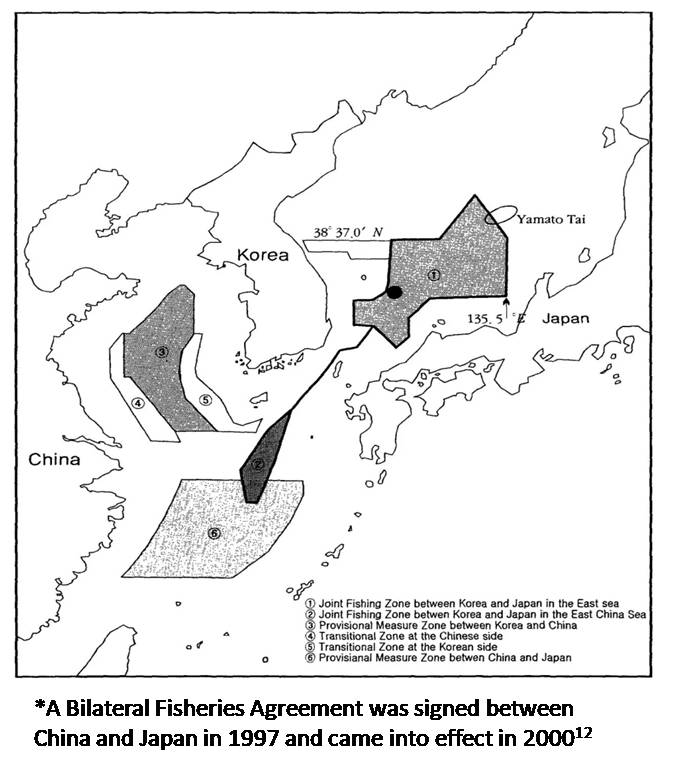
Role of the United States
The 1960 US-Japan Security Treaty states that an armed attack on either party in the territories under Japan’s administration would prompt joint action “to meet the common danger.” In 2014, US President Obama publicly said the US security treaty with Japan covered the Senkaku Islands because they “are under Japanese jurisdiction,” yet “we also stress that we don’t take a position on the sovereignty of the Senkaku Islands.” This prompted strong fears regarding the resoluteness of US commitment towards Japan. However, in one of the first summit meetings during Trump presidency in February 2017, the Trump-Abe Joint Statement came out strongly for the Senkakus’ defence. The two leaders affirmed that Article V of the US-Japan Treaty of Mutual Cooperation and Security covers the Senkaku Islands and opposed any unilateral action that sought to undermine Japan’s administration of these islands13. In July 2020, Lt. Gen. Kevin Schneider, the highest-ranking US military officer in Japan issued a rare reaffirmation that the United States is 100% absolutely steadfast in its commitment to help the government of Japan with the “unprecedented” situation14.
Access Dilemma for China
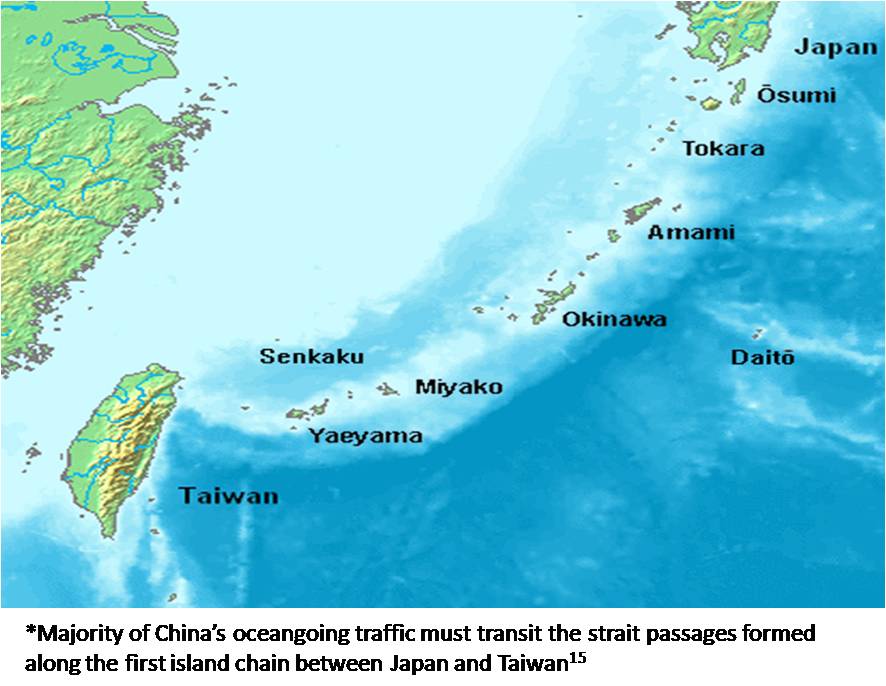
The proximity of Senkakus to Okinawa and Taiwan make it the key for the PLA Navy to exit unhindered and transform into a blue-water navy. Three naval combat-systems engineers from the Marine Design and Research Institute described Beijing’s maritime predicament in stark geopolitical terms. Of the 16 major straits and channels critical to China’s oceanic access, they claim 11 are located along the Ryukyus, under Japanese control16. However, legal measures put in place in 1977 restricted uninhibited foreign maritime traffic to only five of Japan’s many straits: Soya, Tsugaru, Tsushima East, Tsushima West and Osumi. In many ways, this was sufficient. But circumstances have changed, and China has actively started challenging Japanese sovereignty in the East China Sea17. Over the years, the Japanese and Chinese have essentially let the dispute simmer, with China incrementally building a persistent presence in the surrounding waters to eventually fatigue Japanese claims by way of grey-zone coercion. Yet, the irony is the Senkaku Islands dispute may become a potential casus belli and lead to the eventual re-militarization by Japan.
Japanese Response
In 2004, a submerged Chinese submarine entered Japan’s territorial waters near the southern island chain, putting Japan’s military on alert for only the second time since World War II18.Beijing said the vessel suffered a technical glitch and got lost. Yet there are Japanese hesitations that retaliation now will simply give China another ‘provocation’ (reasoning) for Beijing to retaliate against Japan. “The JSDF is gradually being overworked and overwhelmed,” said Grant Newsham, a retired US Marine Corps colonel and researcher at the Japan Forum for Strategic Studies. “Yes, it can go out and respond to Chinese air and sea incursions, but the Chinese are showing (up) in more numbers, in more places, and more often than ever. And the SDF simply does not have the resources to match the Chinese19. In March 2018, a Japanese Amphibious Rapid Deployment Brigade, on the pattern of US Marines, was created with a mandate to defend — and if necessary, retake — Japanese islands that could be target of invasions. In past few years, there has also been a rapid expansion of the SDF presence across the “first island chain” in what is referred to as the “south western wall defence” strategy.
However, as plans for defending the southern islands were worked, Japanese military officials worried about a major weakness. There was only a single runway suitable for conventional military aircraft across the island chain. Japan thus, decided to revamp two flat-top destroyers for use by jet fighters that can take off and land vertically—Japan’s first de facto aircraft carrier since World War II. The first carrier will be ready by early 2023, to be deployed around beginning of 2025. Other investments include the largest fleet of F-35 fighters outside the US and a network of satellites capable of guiding newly procured cruise missiles pinpointedly to their targets20. Beijing’s growing naval prowess has also buoyed its confidence, a mindset that had been absent previously. China is increasingly convinced that it possesses the means and skills at sea to bend Japan to its will. Such confidence will increase the likelihood that Beijing would act in what it currently sees as window of opportunity in a world increasingly distracted by a pandemic and recession. But six of China’s 10 largest commercial ports can be accessed only via the East China Sea. China may thus not want to risk aggravating tension so close to its economic heartland.
Endnotes:
- Senkaku Jinja, https://en.wikipedia.org/wiki/Senkaku_Jinja#:~:text=Senkaku%20Jinja%20(%E5%B0%96%E9%96%A3%E7%A5%9E%E7%A4%BE)%20is,shrine%20is%20dedicated%20to%20Amaterasu.&text=When%20the%20shrine%20was%20founded,had%20been%20on%20the%20island.
- MOFA Japan: About the Senkaku Islands, https://www.mofa.go.jp/region/asia-paci/senkaku/index.html
- Reuters: How debts and double-dealing sparked Japan-China islets row, https://www.reuters.com/article/us-china-japan-family/how-debts-and-double-dealing-sparked-japan-china-islets-row-idUSBRE8AA0EY20121111
- Japan Times: China's 100-day push near Senkaku Islands comes at unsettling time for Sino-Japanese ties, https://www.japantimes.co.jp/news/2020/07/27/national/china-japan-senkaku-islands/
- Review of Island Studies: Japan's Effective Control of the Senkaku Islands, https://www.spf.org/islandstudies/research/a00005.html
- Diplomat: Getting Senkaku History Right, https://thediplomat.com/2013/11/getting-senkaku-history-right/#:~:text=Under%20the%20Treaty%20of%20Shimonoseki,bilateral%20negotiations%20on%20the%20treaty.
- In The East China Sea, China Crosses A Line, https://www.opinionglobal.cl/in-the-east-china-sea-china-crosses-a-line/
- US EIA: East China Sea, https://www.eia.gov/international/analysis/regions-of-interest/East_China_Sea
- Disputed Claims in the East China Sea, https://www.nbr.org/publication/disputed-claims-in-the-east-china-sea/
- RAND: A Short History of China's Fishing Militia and What It May Tell Us, https://www.rand.org/blog/2020/04/a-short-history-of-chinas-fishing-militia-and-what.html
- Foreign Policy: China’s Hidden Navy, https://foreignpolicy.com/2019/06/25/chinas-secret-navy-spratlys-southchinasea-chinesenavy-maritimemilitia/
- https://i1.wp.com/sinonk.com/wp-content/uploads/2012/07/fishing-areas-in-yellow-sea1.jpg?ssl=1
- Japan Times: Japan's Senkaku challenge, https://www.japantimes.co.jp/opinion/2017/02/27/commentary/japan-commentary/japans-senkaku-challenge/#.X0eFcnkzbIU
- Nikkei Asian Review: US pledges to help Japan with 'unprecedented' Chinese incursions, https://asia.nikkei.com/Politics/International-relations/US-China-tensions/US-pledges-to-help-Japan-with-unprecedented-Chinese-incursions
- https://en.wikipedia.org/wiki/File:Location_of_the_Ryukyu_Islands.JPG
- The Japanese Archipelago through Chinese Eyes, https://jamestown.org/program/the-japanese-archipelago-through-chinese-eyes/
- Japan Times: Understanding Japan's southwest islands buildup, https://www.japantimes.co.jp/opinion/2019/04/22/
- Wall Street Journal: China Provocations Hasten Japan’s Military Revival, https://www.wsj.com/articles/japan-china-military-provocations-revival-disputed-islands-pacifism-11594735596
- Ibid, no. 3
- Ibid, no. 17
commentary/japan-commentary/understanding-japans-southwest-islands-buildup/#.XuzuE2gzbIU
(The paper is the author’s individual scholastic articulation. The author certifies that the article/paper is original in content, unpublished and it has not been submitted for publication/web upload elsewhere, and that the facts and figures quoted are duly referenced, as needed, and are believed to be correct). (The paper does not necessarily represent the organisational stance... More >>
Image Source: https://cdn1.i-scmp.com/sites/default/files/styles/1200x800/public/images/methode/2019/02/22/eb37919c-2e72-11e9-80ef-0255f1ad860b_image_hires_171004.JPG?itok=DdjVOsVj&v=1550826607

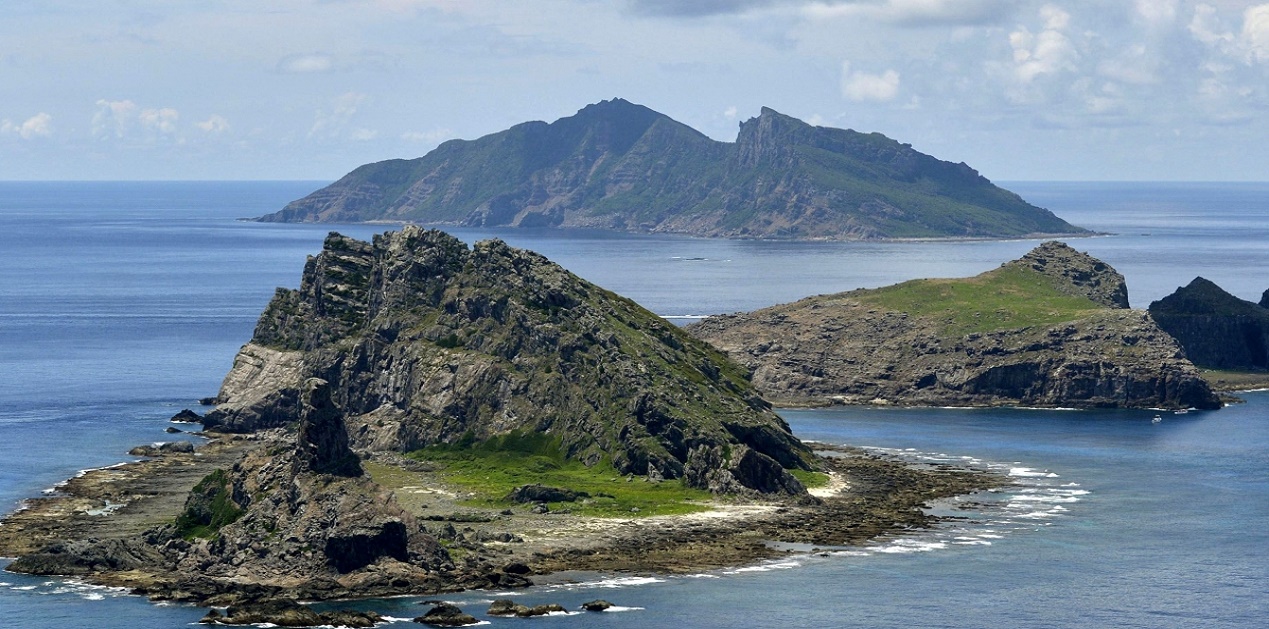









Post new comment